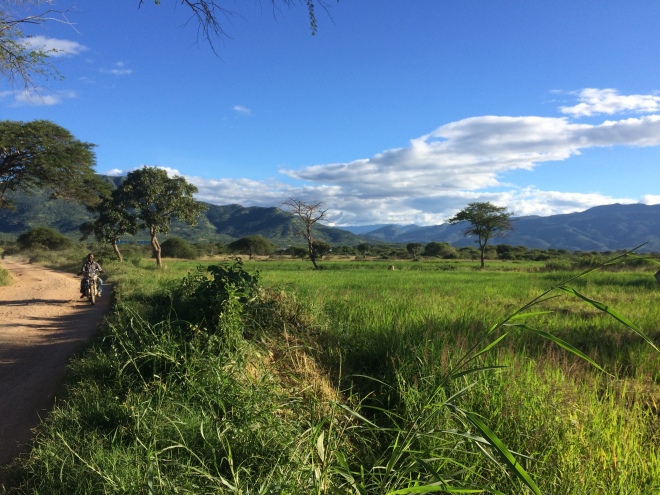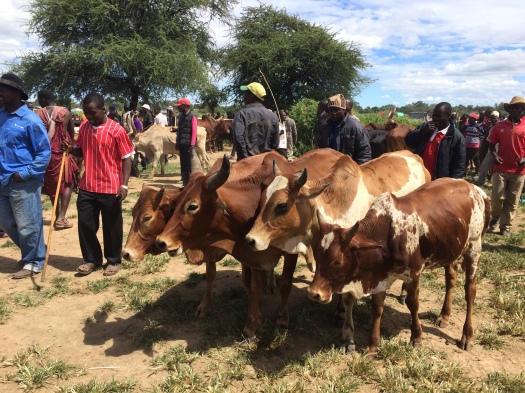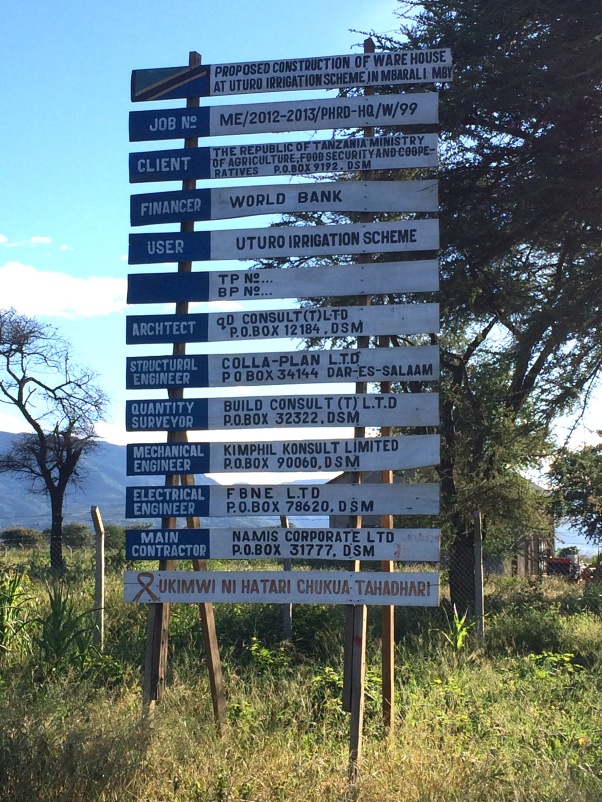Editor’s note: The below post by Frances Cleaver is the third of three initial pieces on this blog that will explore the aims and conceptual bases of the Greenmentality project.
Environmental governance and institutional bricolage
How can we best understand the ways in which environmental governance is enacted through institutions and the variable outcomes produced? Can an institutional focus illuminate how power is exercised, and the ways in which different actors respond to power dynamics? In this piece I outline how processes of institutional bricolage, and the exercise of agency by bricoleurs, shapes the governance of resources in the green economy. [1]

Bricolage: adaptation, authority and meaning [2]
The term institutional bricolage refers to the processes in which people draw on existing components (practices, rules, norms, relationships, symbols) to piece together new or adapted arrangements in response to changing situations. The institutions produced through these processes are dynamic hybrids of ‘modern’ and ‘traditional’ formal and informal elements. Many of the institutions we see at the local level can be understood as hybrid arrangements. Examples include the women’s savings group that also collects funds and organizes maintenance for the water point (Cleaver 2012); or the forest management committee that also acts as a social security or welfare group (De Koning 2011).
Whilst the term bricolage is often used to emphasise creative adaptation, the concept of institutional bricolage goes beyond improvisation in a number of ways. For arrangements formed through bricolage to become institutionalized, to be more than diverse and ad hoc practices, they must seem normal to the people who practice them. Such normalization occurs through processes of bestowing authority and of imbuing the new or adapted arrangements with legitimacy and meaning. Authority, in the form of artefacts, symbols, mechanisms, discourses, and sanctioned power relationships, is borrowed from other settings and other times. Legitimacy and meaning is effected through calls on tradition (which may be invented) and by analogy to accepted ways of doing things and ideas about proper orders in social, natural and spiritual worlds (Douglas 1987). In these ways the possibilities of creative improvisation are tempered by reliance on the materials at hand, borrowed from past or current arrangements. This means that institutions formed through bricolage are entwined in the multiple micro power relationships of everyday life, but also in the broader longue durèe of societal resource allocations and governance dynamics.
Bricoleurs and the exercise of agency within structural constraints
Institutions are animated by people who innovate and adapt in response to changing circumstances. These actions are shaped by the resources available to them, their multi-dimensional social identities, the webs or networks of relationships and interdependencies that link them to other actors and broader societal allocations and trends. For example, Schnegg and Linke (2015) suggest that water management arrangements amongst pastoralists in Namibia are strongly and inequitably shaped by networks of social relationships, often disadvantaging poorer pastoralists in relation to their richer neighbours.
A categorisation derived from Giddens (1997) helps us to understand how some bricoleurs are able to exercise power to shape resource management arrangements through their command of allocative resources (material, money, labour, infrastructure) and of authoritative resources (discourses, symbols, roles, policies). Whilst everyone is potentially capable of being a bricoleur, some are able to command more resources across different social domains to make adaptations work in their favour. It is significant that at village level we often see the same people (or their relatives) holding posts and positions of influence across different institutions – for example on the Water User Association, and the Village Council, and perhaps the church or the council of traditional elders. In such a case, the resources of authority (derived for example from being a traditional elder) are then imported into the way that person exercises influence in the Water User Association. The exercise of power in environmental governance, then, is not separate from, but entwined with, the authoritative relations of social life.
Importantly, people exercise agency consciously and non-consciously. The partially non-conscious nature of agency (as evident in habitual behaviours, internalisation of ideas about order, proper behaviour and so on) accounts for some of the invisible workings of power and the ways in which hegemonic discourses and relationships shape people’s views of the possibilities and appropriate forms of action (Cleaver 2018). For example, in our research in Tanzania we find many people in local government casually reproducing biases against pastoralists in the ways that they speak about them and analyse environmental problems. The exercise of agency is not just about deliberate responses to situations and events but also about accommodating individual behaviour to taken-for -granted societal discourses (which may be shaped by the ‘invisible’ workings of power (Lukes 2005)).This helps to explain why disadvantaged people do not necessarily see unequal environmental relations as unfair or unjust and do not always resist (Walker 2014).

The multiple dimensions of agency mean that bricoleurs defy easy categorisation. For example a low-caste or tribal woman in India may be socially and economically disadvantaged in many ways but have more access to the public sphere than higher caste women confined to the domestic arena. Or the leader of an association of small-scale outgrower farmers in Tanzania may be seen to inhabit somewhat contradictory identities both in opposition to and in negotiation with the employer company. Delgado and Zwarteveen (2007), examining the ways in which institutions shape women’s access to land and water in Peru, find that differing approaches are influenced by the women’s differential command of resources ( land, knowledge, family networks). Some women work within the boundaries of ‘traditionally’ gendered social water organisations, and some challenge these and strive to assert their rights in more ‘masculine’ domains of official irrigation institutions. The multiplex nature of individual identity and consciousness offers both opportunity and constraint in the making of environmental governance and helps to account for some of the unanticipated and inconsistent outcomes. It is potentially a helpful way of understanding the variety of ‘responses from below’ that may well co-exist in any one governance situation.
The possibilities and constraints bricoleurs face are well illustrated by studies of how District Environment Officers (Funder and Marani 2015) in Kenya navigate their way through plural governance landscapes, drawing on a variety of resources, relationships and arrangements to ensure that they get the job done. Funder and Marani (2015) argue that the creative exercise of agency by bricoleurs can help to make governance work even in constrained situations, such as in the absence or weakness of government or other development agencies. In their case, Environment Officers worked by cultivating personal networks and piggybacking on established authorities; tailoring informal agreements or ‘by-laws’ with communities and delegating public authority to community organisations. Such studies are useful for linking processes of bricolage to the functioning of ‘interface bureaucracies’, to the translation of policy into local level practices and arrangements, and to the role of local bureaucrats as intermediaries between interventions imposed from above and reactions from below.
The promise of institutional bricolage
It is argued by some that processes of bricolage can result in institutions that are adaptive, resilient and locally embedded – practical hybrids or ‘arrangements that work’ in particular times and places. Blending, layering and piecing together can generate ‘thickness’ in institutions, and help to explain their endurance through adaptation over time. A plural institutional landscape (with overlapping policies, rights regimes, approaches and actors) is often seen as an opportunity for bricoleurs, offering multiple resources for the assembling of arrangements and scope for creativity. For example, Lecoutere (2011) explored interactions over land and water resources in small-scale irrigation schemes in Tanzania. She found that when faced with potential conflicts over land and water, people were able to pragmatically re-make institutions, following a variety of institutional channels and invoking a variety of norms for conflict resolution. The result was less conflict than might be anticipated in a landscape of competing claims to limited resources. However, this ability to navigate the institutional landscape did not apply to everyone – a point we consider further below.
Whilst institutional bricolage has often been studied at the local community level, Walter and Urkidi (2013) consider what happens when local-level resistance is enabled through processes of institutional bricolage across wider scales. Their study of community consultations on large-scale mining activities in Latin America explores how local consultations, challenging the ways in which large scale mining is governed, have emerged and spread through processes of social learning. They claim that happened through the sharing, borrowing and adapting of strategies and discourses between localized social movements, and also through hybridizing processes which facilitated ‘fit’ of standardized consultations with local political and social dynamics.
In a less political and more pragmatic, development focused view, there is a debate about the extent to which institutional bricolage can be facilitated by development planners and practitioners to ensure institutions that work in local conditions, (Merrey and Cook 2012; Jones 2015). This debate bridges to views about the designability of institutions – the idea that particular mechanisms and arrangements can be consciously selected, and other discarded. However, from a bricolage perspective, all institutions partially elude design. Therefore, all attempts to govern – from top down interventions to facilitated bricolaged arrangements – are likely to be partial, creating spaces and grey areas which can be utilised for unintended purposes.
The dark side of institutional bricolage
Without rejecting the creative potential of institutional bricolage, several studies also focus on the ways in which power is exercised, and inequalities perpetuated, through bricolaged arrangements. Blending, layering and drawing on acknowledged sources of authority also creates ‘stickiness’ – the persistence of entrenched power differentials. Social inequalities are often reproduced as resourceful people consolidate their influence across a variety of institutions. In a study of water management in urban areas of Lilongwe, Malawi, Rusca et al., (2014) show how chiefs and landowners were able to ‘capture’ hybrid Water User Associations. Through this they gained access to decision-making power and to material benefits (allowances, social welfare payments) which were disproportionately large compared to those of more lowly water actors.
Path dependence, power relations and national and global governance frameworks may also constrain attempts to innovate and negotiate (Sehring 2009). Bricolage processes can help to legitimize particular policies and governance arrangements as well illustrated by Buseth’s (2017) analysis of the ways in which Tanzania’s Southern Agricultural Growth Corridor has been discursively legitimized as a ‘green economy’ initiative, whilst also promoting agricultural intensification, the interests of elites and of international businesses.

Deliberate attempts to create governance arrangements through bricolage may achieve certain prioritized objectives (such as a wildlife conservancy in Kenya, or a tiger conservancy in India), apparently blending interests and actors into a joint endeavor for the common good. However, the resulting arrangements are rarely alliances of equals and a bricolage lens may help us to analyse how the more powerful actors are able to deploy authoritative and allocative resources to gain disproportionate influence over them. This clearly overlaps with a governmentality lens and of the visible, hidden and invisible dimensions of power.
Questions arising
An institutional bricolage perspective prompts the following questions in relation to the greenmentality research project:
- How can we conceptualise and explain the variety of ‘responses from below’ in relation to institutional engagement?
- When do reactions from below become more than just ad hoc responses to perceived threats or opportunities? When and how do they become institutionalised?
- How far are bricoleurs able and/or willing to pragmatically adapt or rework green economy interventions in order to benefit from them?
- How do elements of green economy interventions become redeployed to create everyday natural resource access arrangements with perceived social fit? Which elements become ‘naturalised’ (and whose interests are promoted in this way?)
- Can processes of institutional bricolage be selectively facilitated in order to shape governance arrangements in progressive ways?
A fruitful way of pursuing such questions lies at the intersection of ideas about governmentality, power and institutional bricolage. We hope to generate insights into how particular forms of governance produce winners and losers by deploying these conceptual lenses in our research on the green economy.
Endnotes
[1] I acknowledge with thanks some of the examples in the text which were offered by colleagues in discussion at the Greenmentality workshop in India, December 2017.
[2] For a fuller understanding of the nature of institutional bricolage in relation to critical institutionalism see Cleaver 2012, chapters 1 and 2, Hall et al 2013 and Cleaver and De Koning 2015.
References
Booth, D (2012). Development as a Collective Action Problem: Addressing the Real challenge of African Governance, Africa Power and Politics Programme, Synthesis Report. London: Overseas Development Institute.
Buseth, J (2017). The green economy in Tanzania: From global discourses to institutionalization Geoforum 86, 42-52.
Cleaver, F.D. & de Koning, J (2015). Furthering critical institutionalism. International Journal of the Commons. 9(1), pp.1–18.
Cleaver, F (2002). Reinventing Institutions: Bricolage and the Social Embeddedness of Natural Resource Management. The European Journal of Development Research 14(2): 11–30.
Cleaver, F (2012). Development through Bricolage: Rethinking Institutions for Natural Resource Management. London: Routledge. 2012
Cleaver, F, Franks, T, Maganga, F and Hall, K (2013). Institutions, Security, and Pastoralism: Exploring the Limits of Hybridity. African Studies Review 56(3): 165–189.
De Koning, J (2011). Reshaping Institutions – Bricolage Processes in Smallholder Forestry in the Amazon. PhD thesis. Wageningen: Wageningen University. 2011.
Delgado, J. V and Zwarteveen, M (2007). The Public and Private Domain of the Everyday Politics of Water. International Feminist Journal of Politics 9(4): 503–511.
Douglas, M (1987). How Institutions Think. London: Routledge and Kegan Paul.
Funder, M and Marani, M (2015). Local Bureaucrats as Bricoleurs. The Everyday Implementation Practices of County Environment Officers in Rural Kenya. International Journal of the Commons 9(1): 87–106.
Giddens, A (1984). The Constitution of Society: Outline of the Theory of Structuration. Cambridge: Polity Press.
Hall, K, Cleaver, F, Franks, T and Maganga, F (2014). Capturing Critical Institutionalism: A Synthesis of Key Themes and Debates. European Journal of Development Research 26: 71–86.
Jones, S (2015). Bridging Political Economy Analysis and Critical Institutionalism: An Approach to Help Analyse Institutional Change for Rural Water Services. International Journal of the Commons 9(1): 65–86.
Lecoutere, E (2011). Institutions under Construction: Resolving Resource Conflicts in Tanzanian Irrigation Schemes. Journal of East African Studies 5(2): 252–273.
Lukes, S (2005). Power: A Radical View. New York: Palgrave Macmillan.
Merrey, D and Cook, S (2012). Fostering Institutional Creativity at Multiple Levels: towards Facilitated Institutional Bricolage. Water Alternatives 5(1): 1–19.
Peters, I, Christoplos, I, Funder, M, Friis-Hansen, E and Pain, A (2012). Understanding Institutional Change: A Review of Selected Literature for the Climate Change and Rural Institutions Research Programme. DIIS Working Paper 2012: 12.
Rusca M Klaas, Schwartz K, Hadzovic C and Ahlers R (2015). Adapting Generic Models through Bricolage: Elite Capture of Water Users Associations in Peri-urban Lilongwe, The European Journal of Development Research 27, 5, 777-792.
Schnegg, M and Linke, T (2015). Living Institutions: Sharing and Sanctioning Among Pastoralists in Namibia. World Development 68: 205–2014.
Sehring, J (2009). Path Dependencies and Institutional Bricolage in Post-Soviet Water Governance. Water Alternatives 2(1): 61–81.
Walker, G (2014). Editorial: Environmental justice as empirical and normative. Analyse und Kritik 715. 36(2):221-227.
Walter, Mariana & Urkidi, Leire (2015). Community mining consultations in Latin America (2002–2012): The contested emergence of a hybrid institution for participation. Geoforum. 10.1016/j.geoforum.2015.09.007.

